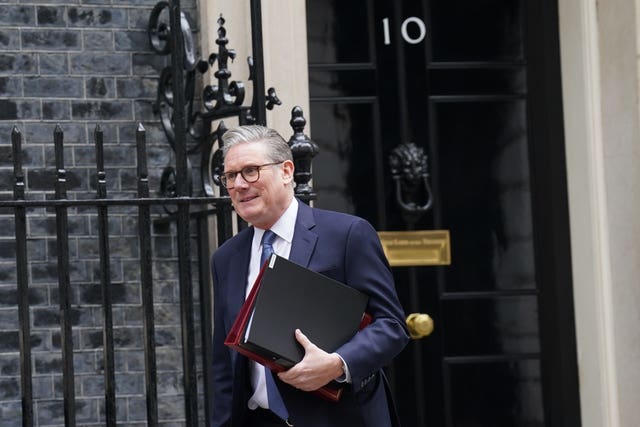
The Chancellor’s spring statement included changes to controversial welfare reforms announced last week.
Here the PA news agency details the changes and their potential implications.
– What was initially announced by the Government?
Sir Keir Starmer insisted the current benefits system is “morally and economically indefensible”, as the Government announced measures last week that would save an estimated £5 billion-a-year by the end of the decade.
These included the reintroduction of reassessments for people on incapacity benefits, alongside improved support aimed at ensuring claimants “aren’t indefinitely written off”.

In a bid to to focus personal independence payments (Pip) on those with higher needs, eligibility requirements would be tightened from November 2026 for the “daily living element” of the benefit.
A consultation was also promised on delaying access to the health element of universal credit to those aged 22 and over, with the aim of reinvesting savings to support young people into work or training.
– What changes were announced in the spring statement?
The changes to welfare reforms announced by Rachel Reeves mean some further reductions in benefits.
The Government previously announced a rise in the standard allowance for universal credit for 6.5 million people.
This rise will now be £1 lower a week than previously stated.
The health element of universal credit for those with limited capacity to work was initially set to be halved for new claimants to £50 a week in 2026-27, then frozen.
Now the Government has said existing claimants will have their entitlement frozen at £97 a week until the end of the decade.
– What impact are welfare changes expected to have?
The Department for Work and Pension’s assessment of the impact of the changes was published today.
It found that by 2020 more than three million families will lose out financially as a result of the welfare cuts, an average loss of £1,720 annually.
The assessment also said the changes will leave an estimated quarter of a million more people, including 50,000 children, in relative poverty after housing costs across Great Britain by the end of the decade.
The document stated this estimate does not include the impact of the £1 billion annual funding, by 2029/30, for measures supporting people into work “which we expect to mitigate the poverty impact”.
The assessment also found that on average 3.8 million families will be £420 a year better off as a consequence of the changes.
The Resolution Foundation said some of the measures should boost work incentives, but they risk being overshadowed by major cuts to disability benefits.
The think tank’s chief executive Ruth Curtice said: “The Chancellor has chosen to make welfare cuts the focus of efforts to meet her fiscal rules in the wake of weaker public finances.
“But while reform to health and disability benefits is needed, the scale and last-minute nature of many of the changes announced today suggest that long-term change is playing second fiddle to short-term savings.”
– Why have the changes been made?
Chief secretary to the Treasury, Darren Jones, described the adjustments as “two little changes”, citing the slight reduction in the health top-up for universal credit and the freeze for existing claimants.
The minister told the BBC the changes were prompted by the spending watchdog, the Office for Budget Responsibility (OBR), taking “a slightly different number” than the Government in its assessment of savings.
When challenged on disabled people losing benefits, Mr Jones added: “I can’t talk about individual cases, but what we are doing is making sure that the most severely disabled are protected.”
– What did the OBR say about the impact on public finances?
The OBR estimates that the impact of the measures as a whole will reduce spending by £4.8 billion by 2029-30.
This is the largest package of welfare savings since the Budget 2015, which announced a four-year freeze to most working-age benefits and included reductions to tax credits and universal credit.
However, the OBR added: “The economic and fiscal impact of these policies are very uncertain due to the complex interaction between trends in health, demography, and the economy and the operation of the benefits system.”
The independent spending watchdog added that it has “limited evidence available to assess the full impact” of the changes, adding previous reforms have, “in many cases, saved much less than initially expected”.
The OBR said the main savings would come from tightening the Pip eligibility, cutting payments for around 800,000 claimants, and slashing the level of health-related universal credit for three million families.
– What are the political implications for the Government?
Paul Johnson, director of the Institute for Fiscal Studies, questioned the Government’s motivation for the changes.
He said: “Knocking a pound a week off the main rate of universal credit in order, it seems, to return the fiscal headroom to exactly where it was last October, really does risk undermining the idea that benefit reform, which is much needed, is being made for any reason other than chasing a fiscal number.”
This suggestion that the changes were made simply to tidy up the books could further anger Labour MPs who have spoken out against the plans, and those who are uneasy with the changes but have chosen not to.
Legislation will be required for some elements of the changes, raising the prospect of a potential rebellion.


Comments: Our rules
We want our comments to be a lively and valuable part of our community - a place where readers can debate and engage with the most important local issues. The ability to comment on our stories is a privilege, not a right, however, and that privilege may be withdrawn if it is abused or misused.
Please report any comments that break our rules.
Read the rules hereLast Updated: 1st January 1970 12:00 am
Report this comment Cancel